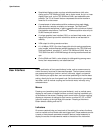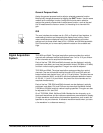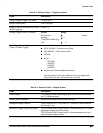
Specifications
Specifications
self-diagnostic features built into the Digitizing Oscilloscope to aid in fault
detection and servicing are also accessible using commands sent from a
GPIB controller.
Another standard feature is hardcopy. This feature allows you to output
waveforms and other on-screen information to a variety of graphic printers
and plotters from the Digitizing Oscilloscope front panel, providing hard copies
without requiring you to put the Digitizing Oscilloscope into a system-control-
ler environment. You can make hardcopies in a variety of popular output
formats, such as PCX, TIFF, BMP, RLE, EPS, Interleaf, and EPS mono or
color. You can also save hardcopies in a disk file in any of the formats above.
The hardcopies obtained are based on what is displayed on-screen at the
time hardcopy is invoked. The hardcopies can be stamped with date and time
and spooled to a queue for printing at a later time. You can output screen
information via GPIB, RS-232C, or Centronics interfaces.
The TDS 520A, 524A, 540A and 544A Digitizing Oscilloscopes offer flexible
display options. You can customize the following attributes of your display:
Color: Waveforms, readouts, graticule, etc. on the TDS 524A and 544A;
Intensity: waveforms, readouts, and graticule;
Style of waveform display(s): vectors or dots, intensified or non-intensified
samples, infinite persistence, and variable persistence with color coding;
Interpolation method: Sin(x)/x or Linear;
Display format: xy or yt with various graticule selections including NTSC
and PAL to be used with video trigger.
Zoom
This Digitizing Oscilloscope also provides an easy way to focus in on those
waveform features you wish to examine up close. By invoking zoom, you can
magnify the waveform parameter using the vertical and horizontal controls to
expand (or contract) and position it for viewing.
Display


















